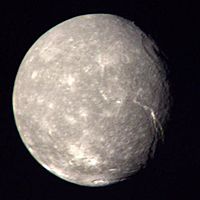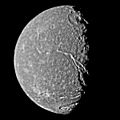Titania (moon) facts for kids
 Click image for description |
|||||||
| Discovery | |||||||
|---|---|---|---|---|---|---|---|
| Discovered by | William Herschel | ||||||
| Discovered in | January 11, 1787 | ||||||
| Orbital characteristics | |||||||
| Semi-major axis | 435,910 km | ||||||
| Mean radius | 436,300 km | ||||||
| Eccentricity | 0.0011 | ||||||
| Orbital period | 8.706 d | ||||||
| Inclination | 0.340° (to Uranus' equator) | ||||||
| Is a moon of | Uranus | ||||||
| Physical characteristics | |||||||
| Mean diameter | 1577.8 km
(0.1237 Earths) |
||||||
| Surface area | 7,820,000 km² | ||||||
| Volume | 2,057,000,000 km³ | ||||||
| Mass | 3.526×1021 kg
(5.9×10−4 Earths) |
||||||
| Mean density | 1.72 g/cm³ | ||||||
| Surface gravity | 0.378 m/s2 (~0.039 g) | ||||||
| Escape velocity | 0.77 km/s | ||||||
| Rotation period | synchronous | ||||||
| Axial tilt | zero | ||||||
| Albedo | 0.27 | ||||||
| Apparent magnitude | 13.73 | ||||||
| Surface temp. |
|
||||||
| Atmospheric pressure | |||||||
Titania is the largest moon of Uranus. It is also the eighth biggest moon in our Solar System. This icy world orbits far from the Sun.
Contents
Discovering Titania
Titania was found on January 11, 1787. The famous astronomer William Herschel discovered it. He also found another moon, Oberon, in the same year.
Naming the Moon
The names for Titania and other moons of Uranus came from John Herschel. He was William Herschel's son. He suggested the names in 1852.
All of Uranus' moons are named after characters. These characters are from plays by William Shakespeare or poems by Alexander Pope. Titania gets its name from Titania. She is the Queen of the Faeries in Shakespeare's play A Midsummer Night's Dream.
The moon is also known as Uranus III.
What Titania is Like
The only close-up pictures of Titania are from the Voyager 2 spacecraft. It flew past Uranus in January 1986. At that time, only the southern part of Titania was facing the Sun. So, only that part was studied.
Scientists think Titania is made of different materials. About half of it is water ice. Around 30% is silicate rock. The rest, about 20%, is made of methane-related organic compounds.
Features on Titania's Surface
Features on Titania's surface are named after characters and places from Shakespeare's plays. Large cracks are called chasmata. Steep slopes are called rupes. Craters on Titania are named after female characters.
One very big feature is a huge canyon. It is much larger than the Grand Canyon on Earth. It is similar in size to Valles Marineris on Mars or Ithaca Chasma on Saturn's moon Tethys.
| Feature | Named after | Type | Length (diameter), km | Coordinates |
|---|---|---|---|---|
| Belmont Chasma | Belmont (The Merchant of Venice) | Chasma | 238 | 8°30′S 32°36′E / 8.5°S 32.6°E |
| Messina Chasmata | Messina (Much Ado About Nothing) | 1,492 | 33°18′S 335°00′E / 33.3°S 335°E | |
| Rousillon Rupes | Roussillon (All's Well That Ends Well) | Rupes | 402 | 14°42′S 23°30′E / 14.7°S 23.5°E |
| Adriana | Adriana (The Comedy of Errors) | Crater | 50 | 20°06′S 3°54′E / 20.1°S 3.9°E |
| Bona | Bona (Henry VI, Part 3) | 51 | 55°48′S 351°12′E / 55.8°S 351.2°E | |
| Calphurnia | Calpurnia Pisonis (Julius Caesar) | 100 | 42°24′S 291°24′E / 42.4°S 291.4°E | |
| Elinor | Eleanor of Aquitaine (The Life and Death of King John) | 74 | 44°48′S 333°36′E / 44.8°S 333.6°E | |
| Gertrude | Gertrude (Hamlet) | 326 | 15°48′S 287°06′E / 15.8°S 287.1°E | |
| Imogen | Imogen (Cymbeline) | 28 | 23°48′S 321°12′E / 23.8°S 321.2°E | |
| Iras | Iras (Antony and Cleopatra) | 33 | 19°12′S 338°48′E / 19.2°S 338.8°E | |
| Jessica | Jessica (The Merchant of Venice) | 64 | 55°18′S 285°54′E / 55.3°S 285.9°E | |
| Katherine | Katherine (Henry VIII) | 75 | 51°12′S 331°54′E / 51.2°S 331.9°E | |
| Lucetta | Lucetta (The Two Gentlemen of Verona) | 58 | 14°42′S 277°06′E / 14.7°S 277.1°E | |
| Marina | Marina (Pericles, Prince of Tyre) | 40 | 15°30′S 316°00′E / 15.5°S 316°E | |
| Mopsa | Mopsa (The Winter's Tale) | 101 | 11°54′S 302°12′E / 11.9°S 302.2°E | |
| Phrynia | Phrynia (Timon of Athens) | 35 | 24°18′S 309°12′E / 24.3°S 309.2°E | |
| Ursula | Ursula (Much Ado About Nothing) | 135 | 12°24′S 45°12′E / 12.4°S 45.2°E | |
| Valeria | Valeria (Coriolanus) | 59 | 34°30′S 4°12′E / 34.5°S 4.2°E |
Looking for an Atmosphere
On September 8, 2001, Titania passed in front of a faint star. This event is called an occultation. Scientists used this chance to measure Titania's size more accurately. They also looked for an atmosphere. The data showed that Titania has no atmosphere, or it is extremely thin. It would be much thinner than the atmospheres on Triton or Pluto.
Images for kids
See also
 In Spanish: Titania (satélite) para niños
In Spanish: Titania (satélite) para niños




